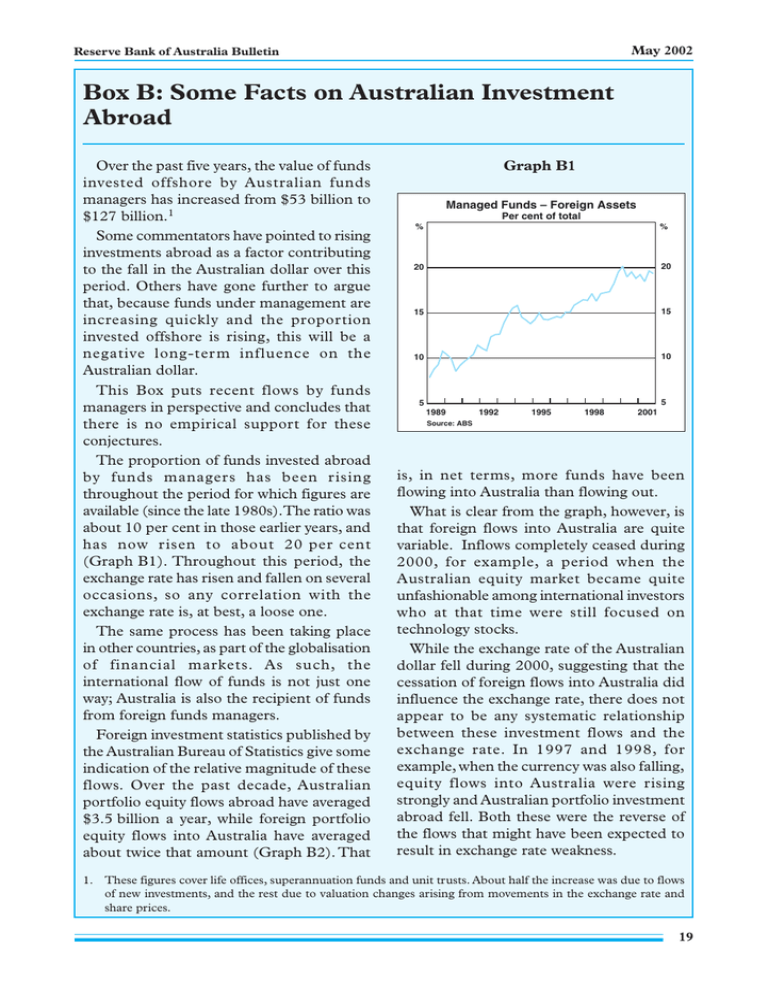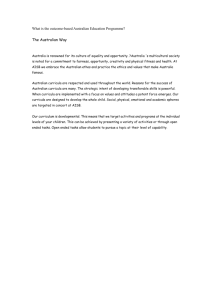Box B: Some Facts on Australian Investment Abroad
advertisement

May 2002 Reserve Bank of Australia Bulletin Box B: Some Facts on Australian Investment Abroad Over the past five years, the value of funds invested offshore by Australian funds managers has increased from $53 billion to $127 billion.1 Some commentators have pointed to rising investments abroad as a factor contributing to the fall in the Australian dollar over this period. Others have gone further to argue that, because funds under management are increasing quickly and the proportion invested offshore is rising, this will be a negative long-ter m influence on the Australian dollar. This Box puts recent flows by funds managers in perspective and concludes that there is no empirical support for these conjectures. The proportion of funds invested abroad by funds managers has been rising throughout the period for which figures are available (since the late 1980s).The ratio was about 10 per cent in those earlier years, and has now risen to about 20 per cent (Graph B1). Throughout this period, the exchange rate has risen and fallen on several occasions, so any correlation with the exchange rate is, at best, a loose one. The same process has been taking place in other countries, as part of the globalisation of financial markets. As such, the international flow of funds is not just one way; Australia is also the recipient of funds from foreign funds managers. Foreign investment statistics published by the Australian Bureau of Statistics give some indication of the relative magnitude of these flows. Over the past decade, Australian portfolio equity flows abroad have averaged $3.5 billion a year, while foreign portfolio equity flows into Australia have averaged about twice that amount (Graph B2). That Graph B1 Managed Funds – Foreign Assets Per cent of total % % 20 20 15 15 10 10 5 5 1989 1992 1995 1998 2001 Source: ABS is, in net terms, more funds have been flowing into Australia than flowing out. What is clear from the graph, however, is that foreign flows into Australia are quite variable. Inflows completely ceased during 2000, for example, a period when the Australian equity market became quite unfashionable among international investors who at that time were still focused on technology stocks. While the exchange rate of the Australian dollar fell during 2000, suggesting that the cessation of foreign flows into Australia did influence the exchange rate, there does not appear to be any systematic relationship between these investment flows and the exchange rate. In 1997 and 1998, for example, when the currency was also falling, equity flows into Australia were rising strongly and Australian portfolio investment abroad fell. Both these were the reverse of the flows that might have been expected to result in exchange rate weakness. 1. These figures cover life offices, superannuation funds and unit trusts. About half the increase was due to flows of new investments, and the rest due to valuation changes arising from movements in the exchange rate and share prices. 19 May 2002 Statement on Monetary Policy Graph B2 Portfolio Equity Flows Moving annual total A$b A$b Net portfolio equity from Australia. The existence of a current account deficit provides the overriding evidence that Australia has an excess of investment opportunities over savings. Graph B3 10 10 Direct Investment Flows Moving annual total A$b A$b A$b Net direct investment 0 0 10 10 0 0 A$b Foreign investment in Australia 10 10 A$b 0 A$b Foreign investment in Australia 0 10 A$b 10 A$b Australian investment abroad 0 10 10 0 0 0 A$b A$b Australian investment abroad 10 -10 1991 1993 1995 1997 1999 2001 10 -10 Source: ABS 0 One of the reasons why there is no systematic relationship between these portfolio flows and the exchange rate is that they are only part of the overall capital flows into and out of Australia. Direct investment by companies, and overseas borrowing and lending, are also important. Over the past year, foreign direct investment abroad by Australian companies was about twice as large as investment abroad by funds managers (Graph B3). Reliable conclusions about the exchange rate therefore cannot be drawn simply on the basis of portfolio flows. Some commentators have also pointed to the increased flow of funds abroad, both by funds managers and companies, as a sign of a lack of investment opportunities in Australia. But this ignores the flows from abroad coming into Australia, which on balance have greatly exceeded the outflows 20 0 -10 -10 1991 1993 1995 1997 1999 2001 Source: ABS Rather than being a sign of some structural deficiency in the Australian economy, the flows of investment abroad should, more appropriately, be seen as par t of the internationalisation of the economy. This process is taking place in most developed countries and brings many benefits to the economy. It does not imply depreciation of the domestic currency or a problem with domestic asset markets. In particular, at the same time as Australian money is looking abroad, fund managers in many other countries are also looking to invest internationally, and many of these are finding Australia an attractive place to invest. R






